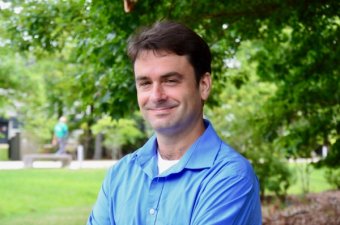One of the major challenges of exploring the inner space of the proton is figuring out how to study the behavior of objects that you can't access directly. Now, Ted Rogers has received a 2017 Early Career Research Program award from the Department of Energy's Office of Science to do just that.
Rogers, who holds a joint appointment with Jefferson Lab and Old Dominion University, was granted the award through his assistant professorship at ODU. He plans to use it to advance research into the building blocks of protons: quarks and gluons.
He says studying quarks and gluons is tricky, because you can't access them directly in experiments. For instance, in a typical experiment at Jefferson Lab, researchers will send a stream of electrons crashing into protons inside nuclei. Detectors sweep up and measure the debris that comes out of these collisions.
"You don't actually see quarks and gluons entering detectors. You see things like protons, pions, things like that," he explained. "We want to be able to look at the details of these experiments and interpret them in terms of the behavior of the quarks and gluons."
To translate what they see in their experiments to what it actually means for the quarks and gluons they're studying, researchers often need tools built on theory to help them.
Rogers' work focuses on factorization. Generally speaking, factorization is a mathematical method that allows researchers to separate the information they have on a whole system into its parts. In terms of particles, such as a proton, it allows them to take information they have on the proton and separate it into information on its building blocks, the quarks and gluons.
"With this award, I'm filling the holes in this theory of factorization," he said. "What we're doing now is trying to interpret the experiment in terms of quarks and gluons in greater detail than had traditionally been possible."
Applying this method isn't easy. Rogers and his colleagues are ultimately using a few pieces of information from experiment to unravel the many different interpretations of what it could mean from the complicated theory of quarks, gluons, and their interactions.
The plan is to develop the theory factorization so that it applies much more broadly than in the past. If successful, the work will allow researchers to get more detailed information than ever before from their experiments. For instance, while the average motion of quarks and gluons along the direction of a proton beam is fairly well-understood, Rogers' work could allow them to also determine how the quark itself is moving within the proton.
"If the proton were moving with very high energy, and this would be the first approximation, you might say 'well the quark is just moving with some fraction of that energy,' and ignore the fact that it's actually wiggling around in there," he said. "If you want to understand the structure of the object in any kind of detail, then you want to get access to that wiggling-around motion."
Rogers' proposal is one of only 59 that were chosen from about 700 for an award. He will receive $150,000 each year for the next five years, which he plans to use to support a graduate student, a postdoctoral researcher and for computational support to carry out the research.
The original article can be found on the Jefferson Lab website here.




